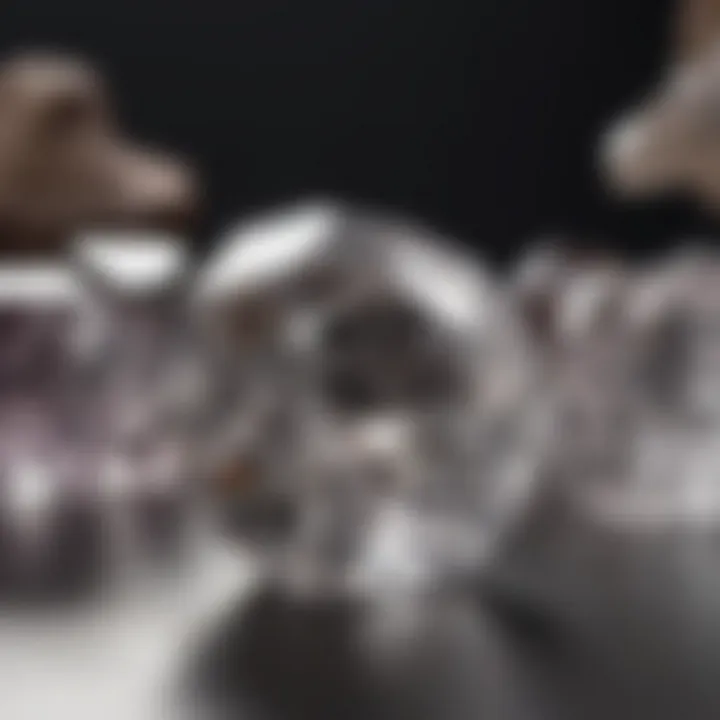Exploring Quartz: Properties, Uses, and Cultural Impact


Intro
Quartz is a mineral that captures the imagination of many, with its crystalline structures sparkling in the light and its wide array of colors. From clear and colorless to stunning hues of amethyst and citrine, quartz is not just another rock; it’s a complex and versatile gemstone that plays significant roles across various fields. In this comprehensive guide, we will delve into the characteristics, historical significance, and applications of quartz, uncovering what makes this mineral truly remarkable.
Gemstone Overview
Definition and Characteristics
Quartz is a silicon dioxide (SiO2) mineral that ranks as one of the most abundant substances in the Earth’s crust. Known for its hardness, it scores a seven on the Mohs scale, making it durable and ideal for various applications. Its crystalline structure can form in different geological environments, leading to the diversification of quartz into several distinct varieties. Among these, we find:
- Clear Quartz: Often referred to as rock crystal, prized for its clarity.
- Amethyst: A purple variant that is widely used in jewelry.
- Citrine: Recognized for its warm yellow to brown hues.
Each type possesses unique features. For example, amethyst is often associated with clarity of thought and peace, while citrine is famous for its supposed ability to attract prosperity.
Classification of Gemstones
Gemstones are typically classified based on several criteria, including their chemical composition, mode of formation, and overall rarity. For quartz, these factors include:
- Natural vs. Synthetic: While natural quartz is mined directly from the earth, synthetic variants are produced in laboratories, closely mimicking nature’s work.
- Precious vs. Semi-Precious: Traditionally, gemstones like diamonds and rubies are considered precious, whereas quartz is often classified as semi-precious. However, the lines can be blurred, especially with high-quality specimens.
In terms of color, quartz varieties can range across the spectrum, making it one of the most versatile gemstones in the market today.
Historical Significance
Ancient Uses and Cultural Importance
The history of quartz stretches far back into ancient civilizations. Cultures across the globe have recognized its value not only for decorative purposes but also for its purported metaphysical properties. In ancient Egypt, quartz was often carved into amulets believed to protect against harm. Similarly, the Aztecs used quartz in their intricate jewelry and artifacts, associating it with healing and spiritual enlightenment.
The varied uses of quartz demonstrate its widespread appeal throughout history. It was not uncommon for ancient cultures to believe that quartz could store energy or even harness the power of the universe itself.
Myths and Legends Surrounding Gemstones
Many legends surround quartz, with numerous stories told about its origins and benefits. One such tale involves the Native American tribes, who believed that clear quartz could enhance wisdom and intuition. This cultural significance has carried into modern times, where quartz is often utilized in spiritual healing practices.
“Crystals are the perfect metaphor for life, their beauty and clarity transformed through pressure and time.”
Such narratives emphasize not just the physical attributes of quartz but its deeper connection to human experience and culture.
Prolusion to Quartz
Quartz, a mineral that can be found in abundance across the globe, holds a critical place in both geological discussions and practical applications. Understanding quartz is not merely about identifying crystal structures or appreciating its beauty; it’s about recognizing its versatility and significance that transcends mere aesthetics. This article seeks to dive into the myriad properties, uses, and implications of quartz in various spheres. Whether you are an enthusiast captivated by its beauty, an industry professional relying on its practical applications, or simply curious about its impact in history and culture, the journey into the world of quartz promises valuable insights.
Defining Quartz
Quartz is primarily composed of silicon and oxygen, forming one of the fundamental building blocks of the Earth’s crust. Its chemical makeup is denoted as SiO₂, which might sound mundane, but the arrangement of these atoms crafts a stunning array of crystal forms. Ranging from transparent clear quartz to richly colored varieties like amethyst and citrine, quartz manifests in diverse appearances, making it not only a subject of study in mineralogy but also a beloved choice among collectors and designers.
What sets quartz apart is its durability and resistance to weathering. This resilience allows quartz to persist through time, forming sedimentary rocks that compose numerous landscapes. In a world where many minerals come and go, quartz stands firm. Fascinatingly, it also plays a role in the production of electronic components due to its piezoelectric properties. This means it can generate an electric charge when subjected to mechanical stress, opening the door to its applications in various technologies.
Historical Context
The tale of quartz doesn’t end with its chemical properties; it also unfolds through history like a tapestry, colored by human interaction and cultural significance. Ancient civilizations recognized quartz's intrinsic value, finding uses in tool-making, jewelry, and even as a talisman. For instance, the ancient Egyptians crafted scarabs and ceremonial items from quartz, believing in its mystical powers. Similarly, various indigenous tribes around the world have historically used quartz for spiritual healing and as an aid in meditation practices.
In the grand historical narrative, quartz reflects the evolution of human craftsmanship and belief systems. As one examines old archaeological findings, one can often spot quartz artifacts that speak volumes of the societies that revered these stones. The story of quartz is thus intertwined not only with geology but also with anthropology, revealing a shared legacy that resonates through time.
"Quartz represents a bridge between the natural world and human culture, revealing the duality of its significance across various realms of existence."
Thus, as we delve deeper into the physical properties, industrial applications, metaphysical beliefs, and the impact of quartz across cultures, it becomes clear that this mineral is not just a subject of study; it embodies a larger narrative that connects various aspects of life, culture, and technology.
Mineralogical Composition
Understanding the mineralogical composition of quartz is vital as it lays the groundwork for appreciating its diverse applications and significance across various fields. Quartz is primarily composed of silicon and oxygen atoms that bond in a continuous three-dimensional framework. This fundamental structure not only gives quartz its durability but also influences its various properties such as clarity, color, and crystalline forms. It's like the backbone of quartz—providing both strength and versatility.
Chemical Structure of Quartz
Quartz's chemical formula, SiO₂, divulges its simple yet effective structure. Each silicon atom (Si) is surrounded by four oxygen atoms (O), forming a tetrahedral shape. These tetrahedra link together to create the characteristic crystalline lattice. The strength of the bonds between the silicon and oxygen atoms contributes to quartz’s remarkable hardness, ranking 7 on the Mohs scale. This enduring nature allows quartz to withstand wear and tear, making it suitable for both industrial applications and jewelry. The unique arrangement of its atoms offers various optical characteristics, making quartz ideal for use in optics and electronics, among other industries.
Types of Quartz
Exploring the various types of quartz reveals not only the sheer beauty that this mineral can exhibit but also the distinct properties likely to engage both enthusiasts and professionals within this space.
Clear Quartz


Clear quartz stands as the most recognized form among its brethren. The transparent aspect is often praised for its versatility in jewelry and decorative items. This type shines brightest with its ability to refract light beautifully, creating dazzling displays. Often called the "master healer," clear quartz is reputed in metaphysical circles for amplifying energy and intention. Its very clarity symbolizes purity, making it a popular choice among both collectors and gem enthusiasts. The advantages of clear quartz lie in its availability and affordability, but its beauty can sometimes be overshadowed by more vividly colored stones.
Amethyst
Amethyst, with its enchanting purple hue, captivates the eye and is widely sought-after. This form of quartz is known for its calming properties, often used in spiritual practices for meditation. Its unique color comes from iron impurities combined with natural radiation. Amethyst’s beauty elevates it to a status symbol in jewelry, giving it an edge in both aesthetic and spiritual dimensions. On the downside, its color can fade under prolonged exposure to intense light, a point worth noting for those looking to maintain its splendor.
Citrine
Citrine's sunny, yellow tones bring warmth and positivity. Often associated with abundance and joy, it's no wonder this quartz variant garners popularity in both jewelry design and collectors’ showcases. Its vibrant color comes from iron impurities, much like amethyst. Citrine is highly regarded for its unique ability to not absorb negative energy. That said, genuine citrine can be quite rare, leading many to encounter heating-treated smoky quartz, which is a less authentic choice but still offers beauty.
Rose Quartz
Rose quartz emanates a soft, delicate pink that evokes feelings of love and compassion. Often hailed as the "stone of love," rose quartz is monumental in both emotional healing and relationship building. Its gentle hue makes it a favorite choice for jewelry, particularly for those who are drawn to its soothing aesthetic and metaphysical properties. However, some may find it less suitable for pieces where durability is a concern because it ranks slightly lower on the hardness scale compared to others.
Ametrine
Ametrine is a unique blend of amethyst and citrine, displaying an eye-catching duality of purple and yellow hues. This rare quartz variation isn't just visually striking; it is believed to balance opposing energies, bringing both harmony and clarity to those who wield it. As both rare and attractive, ametrine finds itself in high demand within the jewelry market. One must, however, consider that its rarity can drive up costs, presenting a potential disadvantage for some.
"The diversity found within quartz types reflects the mineral's versatility and its importance across cultures and industries."
In summary, the mineralogical composition of quartz, along with its various forms, is critical in understanding its significance. Each type of quartz carries its own distinct identity and appeal, rich with stories and uses that extend from ancient civilizations to modern practices. As we dive further into the properties and applications of quartz, recognizing its foundational qualities will help illuminate the many facets of this intriguing mineral.
Physical Properties
Understanding the physical properties of quartz is crucial for anyone interested in this mineral, be it gem enthusiasts, geologists, or even the casual collector. Its unique characteristics not only determine how quartz is utilized across various industries but also influence its value and desirability as a gemstone.
Crystalline Structure
Quartz is best known for its crystalline structure, which is a key aspect of its identity. It typically forms in a hexagonal crystal system, meaning that its crystals tend to take on a six-sided prism shape. This is essential to recognize because the arrangement of silicon and oxygen atoms creates a stable framework that contributes to its durability and strength. Essentially, quartz is hard; it ranks a solid 7 on the Mohs scale of mineral hardness.
This crystalline formation means that quartz can withstand significant wear and tear, making it an excellent choice for applications that demand resilience, such as in electronics and optical devices. Moreover, the color variations in quartz can be understood through the context of its crystalline structure. For instance, the presence of iron or other impurities impacts quartz's color, resulting in various types like amethyst or citrine.
In contrast to softer minerals, quartz does not chip easily, which is a consideration for jewelry makers and designers when they select materials. This characteristic also ensures longevity, a key selling point for both consumers and collectors alike.
"The crystalline structure of quartz is not just a visual treat; it also underpins its practical applications across many industries."
Optical Characteristics
The optical properties of quartz are equally as fascinating as its crystalline structure. Quartz can be transparent, translucent, or opaque, depending on its purity and the presence of impurities. Clear quartz, often referred to as rock crystal, is prized for its clarity and the way it refracts light. This ability to bend light is useful in a variety of optical applications, such as lenses and prisms.
Moreover, quartz exhibits double refraction, or birefringence, which means that it can split a ray of light into two separate rays. This characteristic is particularly valuable in fields that rely on precise optics and imaging technologies.
Additionally, quartz can polarize light, which is vital in various scientific instruments. This is often exploited in microscopy and the development of specialized filters for photography and imaging.
In the realm of jewelry, the optical appearances can add significant value. A well-cut piece of quartz can display a play of light that enhances its aesthetic appeal, making it more desirable to wearers and collectors.
In summary, both the crystalline and optical properties of quartz play pivotal roles in its applications and significance, woven intricately into its nature. Beyond just being beautiful, quartz serves a multitude of functions that resonate, making it a cornerstone in various fields.
Industrial Applications
The field of industrial applications is crucial when delving into the diverse functionalities of quartz. This mineral is not just prized for its beauty in decorative forms, but also for its valuable contributions to various industrial sectors. The sheer versatility of quartz allows it to serve as a fundamental component in technology, manufacturing, and construction. As the industrial demand for high-performance materials continues to rise, quartz stands out due to its unique characteristics like durability, thermal resistance, and optical clarity. Therefore, understanding its role in these areas can help professionals and enthusiasts alike appreciate its broader significance.
Quartz in Technology
Electronics
In the realm of electronics, quartz is revered for its piezoelectric properties. This means it can generate an electric charge in response to mechanical stress, a key characteristic that opens the door to numerous applications, such as oscillators and frequency filters. Devices like smartphones, computers, and radios rely heavily on quartz movements, showcasing its importance in maintaining accurate time and frequency stability.
The precision that quartz offers makes it a go-to choice in electronics production. Its durability and ability to operate effectively across a wide temperature range ensure that devices perform reliably, which is essential for consumer satisfaction.
However, sourcing high-quality quartz can sometimes present challenges. The mining process is not only costly but also environmentally taxing. Potential downsides include the geopolitical implications of where quartz is sourced and the need for sustainable practices that industry leaders must consider.
Optics
When we talk about optics, quartz shines as a prime candidate for lens manufacturing. Its unique ability to transmit ultraviolet light makes it a beneficial choice in applications ranging from scientific instruments to camera lenses. The clarity and low thermal expansion of quartz ensure minimal distortion, which is critical in high-precision optical devices.
Particularly notable is its use in high-end electronics and specialized equipment, such as lasers and microscopes, which demand the highest optical clarity. However, it’s important to mention that the rigidity of quartz can be a limiting factor, as it can sometimes make the optics more brittle, making careful handling essential.
Construction
In construction, quartz is a key player, often found in concrete and other building materials. Its resistance to chemical reactions means that concrete containing quartz aggregates can endure harsh conditions over time. Engineers often favor quartz because it contributes to the overall durability of structures, especially in demanding environments.


Additionally, quartz's aesthetic appeal brings another layer of value. For flooring, countertops, and other interior materials, quartz offers a naturally beautiful finish. Yet, as durable as it may be, the heavier weight of quartz compared to some alternatives can complicate transport and installation, representing a trade-off designers and builders need to consider.
Quartz in Manufacturing
Glassmaking
Glassmaking is another area where quartz truly excels. The high silica content of quartz makes it an essential raw material for producing various types of glass. Silica glass, known for its high transparency and thermal shock resistance, finds applications in everything from windows to laboratory glassware.
One of the key benefits of using quartz for glassmaking is its ability to withstand extreme temperatures without deforming. This unique feature ensures that quartz glass remains stable even under thermal stress, which is imperative in industrial applications. However, the process of melting quartz is energy-intensive, which can have an impact on production costs.
Silica Production
Silica production, derived from quartz, serves as the backbone for a plethora of industries—including ceramics and pharmaceuticals. Silica sand, for instance, is critical in making reinforced concrete and insulating materials, showcasing its versatility.
The high level of purity found in quartz makes it an ideal candidate for silica production. This purity translates into better quality end products, often yielding higher performance. On the flip side, producing high-purity silica requires a thorough and often complex processing method, which may make it more expensive than lower-grade alternatives.
Overall, whether it's in the technology sector, manufacturing, or construction, quartz plays an irreplaceable role across various industries. Its properties enable innovations and maintain standards, while its multi-faceted applications reflect the mineral's significant importance. By understanding these industrial applications, we can better appreciate quartz not just as a gemstone, but as a cornerstone of modern industries.
Metaphysical Properties
Metaphysical properties of quartz hold a fascinating significance within multiple contexts, from ancient traditions to modern practices. This broader understanding of quartz taps into its reputed ability to influence the mind and spirit, which draws numerous enthusiasts and practitioners toward this mineral. Quartz, often labeled as the "master healer," is said to resonate with human energy fields, offering various benefits that some believe can enhance mental clarity, emotional healing, and even spiritual enlightenment.
Healing Properties of Quartz
When looking into the healing properties of quartz, practitioners often highlight its resilience and versatility as a crystal. Many believe that quartz can amplify energies and intentions, acting as a bridge to higher consciousness. This mineral is said to help clear the mind, allowing for clearer thoughts and a better understanding of one's personal journey.
Some key benefits often associated with healing quartz include:
- Emotional Balance: Many people use it to stabilize their emotions, particularly during challenging times, as it is thought to promote inner peace.
- Energy Amplification: Considered to enhance the properties of other crystals, quartz is often paired with other stones in holistic practices to boost their effects.
- Physical Healing: While more anecdotal, some report that placing quartz on specific body parts can alleviate discomfort, harnessing its purported energy healing abilities.
In a world where stress is rampant, the idea that something as simple as quartz can promote tranquility offers a sense of hope and connection to something greater.
Uses in Meditation and Spirituality
The use of quartz in meditation and spirituality is deeply rooted in various traditions. This crystal is often utilized during meditation sessions to achieve a deeper state of mindfulness and relaxation. It’s thought to aid in focusing one's thoughts, which can lead to enhanced clarity during spiritual practices.
In various practices, quartz serves distinct purposes such as:
- Meditation Tool: Many people hold a piece of quartz during meditation, believing it helps to create a calming environment and prevents distractions.
- Spiritual Connection: Enthusiasts often report that quartz can facilitate communication with higher realms or even spirit guides, enhancing their spiritual experiences.
- Energy Clearing: Utilizing quartz in spaces is believed to cleanse the area of negative energy, making it a popular choice for creating serene environments in homes or meditation spaces.
"The simplicity and beauty of quartz lie not just in its form, but in its potential to provide comfort and clarity to seekers of truth."
This connection to the spiritual realm and its reputed benefits make quartz a popular choice amongst meditation practitioners, seekers, and holistic healers alike. Its rich history and varied applications demonstrate the significant role quartz has played across cultures and traditions.
Significance in Different Cultures
The cultural significance of quartz is deeply rooted in human history, often intertwined with beliefs, rituals, and artistic expressions. This chapter aims to shed light on how various civilizations have revered and utilized this mineral and its representations in contemporary society.
Historical Uses in Ancient Civilizations
In ancient times, quartz was not just a mineral; it held potent meanings and practical applications that churned within the fabric of daily life. From the Egyptians to the Greeks, various cultures have attributed significant value to quartz.
- Egyptian Civilization: The ancient Egyptians often used quartz, especially clear quartz, to create intricate carvings and amulets. They saw it as a stone that could amplify power and wisdom. Reports suggest they believed this mineral could ward off evil spirits.
- Greek Mythology: In Greek culture, quartz was associated with the divine. It was often linked with the gods and used in their worship. Clear quartz was fashionable among the elite, thought to represent purity and clarity of spirit.
- Native American Tribes: Many Native American tribes viewed quartz as a stone of power and healing. They incorporated quartz crystals in their spiritual ceremonies, believing these stones could connect them with their ancestors and the spirit world.
Quarry data indicates that the discovery and the use of quartz by these cultures symbolized not only their craftsmanship but also their belief systems. This showcases how quartz was not simply a material, but a key player in the narrative of their existences.
Modern Cultural Symbolism
Jumping to modern times, quartz continues to be a culturally significant stone. It transcends mere physical beauty, often symbolizing various virtues and ideologies.
- New Age Movement: Many modern spiritual practices consider quartz as a universal crystal. This led to an influx of quartz in metaphysical shops, where individuals believe it can enhance meditation and personal growth.
- Jewelry and Fashion: In contemporary fashion, quartz's various colors and unique structures make it a popular choice for jewelry. Pieces often serve as statements of individuality and style.
- Rose Quartz, for example, is linked to love and compassion in modern practice, prized for its soft hue and soothing qualities.
- Amethyst is seen not just for its beauty, but also as a stone that provides clarity and calmness, appealing to both fashion enthusiasts and spiritual seekers alike.
"In every culture that has ever existed, quartz has carved out a niche that speaks to the collective consciousness of humanity."
Understanding these nuances deepens our appreciation for quartz beyond its physical attributes. From being sacred items in ancient rituals to chic accessories in today's wardrobe, quartz embodies a range of meanings and narratives, forging connections through time.
Quartz in Jewelry
Quartz holds a special place in the world of jewelry, carving out a niche that reflects both tradition and modern styles. Its allure primarily lies in its variety, beauty, and affordability. Alluring not just to collectors but also to casual jewelry wearers, quartz’s diverse types and captivating colors make it an essential component for many designs and collections. Understanding the various aspects of quartz jewelry can truly elevate one’s appreciation for this mineral and its myriad incarnations.


Types of Quartz Jewelry
Beaded Necklaces
Beaded necklaces featuring quartz are not just fashion statements; they are often imbued with meanings and attributes that date back centuries. Each bead, whether it’s striking clear quartz or a warm amethyst, tells a story and reflects the wearer's personal taste. The key characteristic of beaded necklaces made from quartz is their versatility. They can easily transition from casual wear to formal occasions.
One popular choice is a simple strand of clear quartz beads, which can add elegance to any outfit. But trust me, while they may seem basic, these necklaces can often be a beneficial choice in terms of their various meanings concerning clarity and healing properties.
A unique feature of beaded necklaces is their infinite combinations. From the size to the color and style of the beads, each piece can be customized, catering to personal aesthetics or specific occasions. However, it's crucial to be mindful of the design, as a poorly made beaded necklace can risk pulling apart or losing its charm over time.
Earrings
Earrings crafted from quartz can elevate one’s daily look with minimal effort. They come in an array of forms from dangling designs to simple studs. The key characteristic of quartz earrings is their lightness, making them comfortable for prolonged wear. For instance, simple rose quartz studs can be an excellent choice for those looking to incorporate a touch of color without overwhelming their outfit.
Moreover, earrings made from quartz hold unique advantages. The translucence is capable of catching light beautifully, giving a glimmer that draws attention. However, potential disadvantages can arise from the sensitivity of certain quartz types; amethyst, for instance, may fade if exposed to sunlight for extended periods. This factor should certainly be considered when selecting quartz earrings as a lasting accessory.
Watches
Quartz watches have carved out their unique sector in the wristwatch industry, marrying functionality with aesthetic value. The key characteristic here is reliability. Often, these watches utilize quartz movements—renowned for their accuracy compared to mechanical counterparts. Many brands feature quartz in their luxury watches, making it an ideal choice for discerning buyers looking for quality without the hefty price tag.
The unique feature that makes quartz watches stand out is their low-maintenance nature. Unlike mechanical watches that may require regular servicing, quartz watches usually only need a battery change once in a while. This ease of use makes them highly desirable for busy professionals who appreciate both style and practicality.
However, it’s essential to be aware of some disadvantages; some may view quartz watches as less prestigious compared to their traditional mechanical counterparts. This perspective could make finding a quartz watch that fits both style and sentiment slightly tricky, but certainly not impossible.
Caring for Quartz Jewelry
Keeping quartz jewelry in optimal condition requires a bit of attention but is quite manageable. Periodic cleaning is important to preserve the stone’s brilliance. Using a soft cloth and mild soap with water is typically sufficient.
- Avoid harsh chemicals: Cleaning solutions that are too abrasive can dull or damage the quartz.
- Store diligently: Storing quartz jewelry in soft pouches or boxes helps prevent scratches and tangling with other pieces.
- Mind the heat: Some types of quartz can be sensitive to extreme temperatures, which can cause cracking.
Understanding the importance of care helps embrace the longevity of your quartz jewelry, ultimately preserving its beauty and significance in your collection. While each piece comes with its own distinct traits and values, the essence of quartz jewelry remains a splendid blend of art and nature.
Market Trends and Valuation
The market trends and valuation of quartz are pivotal in understanding its journey from the Earth’s crust to becoming a sought-after commodity in various industries. Over recent years, the demand for quartz has climbed, spurred on by its versatility and unique characteristics that appeal to both industrial users and collectors alike. This section delves into the factors influencing the current market dynamics, offering insight into the compelling relationship between quartz's properties and its market valuation.
Current Market Demand for Quartz
In today's fast-paced technological world, quartz has taken on significant importance, with its applications spanning multiple sectors.
- Electronics: The electronics industry relies heavily on quartz for its precision components—like oscillators and crystal watches. With technology continuously advancing, the demand for high-quality quartz crystals remains robust.
- Jewelry Making: Consumers are increasingly gravitating towards gemstones, leading to a higher demand for quartz-based jewelry pieces. Designs that incorporate clear quartz and amethyst are especially popular due to their aesthetic appeal and price accessibility.
- Construction and Manufacturing: An increasing interest in sustainable building materials is pushing up the demand for engineered quartz surfaces, used in countertops and tiles. Builders appreciate these products for their durability and low maintenance needs.
"Quartz is not just a trend; it's a foundational material that’s irreplaceable in various industries."
Factors Affecting Quartz's Value
Quality
Quality is a significant determinant of quartz's value, often reflecting both its visual aesthetics and physical properties. High clarity and minimal inclusions typically characterize premium quartz types. This level of clarity not only enhances the visual appearance but also impacts its desirability.
- Unique characteristics: Quality quartz possesses a transparency that allows light to refract beautifully, adding to its allure and making it a preferred choice for jewelry and decorative objects.
- Benefits: Higher quality quartz is often seen as an investment, due to its longer-lasting appeal and greater potential for appreciation over time.
Origin
The origin of quartz plays a significant role in its valuation. Different regions are known for producing quartz varieties that carry distinctive features and lore.
- Key characteristics: For instance, Brazilian amethyst is famed for its deep purple hue, while the Himalayan quartz can be valued for its purported healing properties.
- Benefits: Origin can boost a quartz piece's narrative, making it more appealing to collectors and designers who appreciate the story behind the stone. The provenance can substantially elevate its status in the market, transforming it from a mere stone to a treasured artifact.
Market Trends
Market trends are continuously shaped by various factors including consumer preferences, technological innovations, and economic conditions.
- Unique features: Currently, there's a noticeable shift towards ethically sourced and sustainable materials, influencing how quartz is marketed and valued in modern applications, especially in jewelry and home decor.
- Benefits: Adapting to these trends can offer businesses a competitive edge, leading to increased sales and brand loyalty among conscientious consumers.
By analyzing these elements, one can gain a nuanced understanding of why certain quartz varieties may fetch higher prices than others and how the marketplace may evolve in the coming years. Understanding market trends and valuation benefits not just industry professionals but also gemstone enthusiasts looking to deepen their knowledge of this fascinating mineral.
Culmination
As we draw the curtains on our exploration into the realm of quartz, it is essential to reflect on why this mineral holds such resonance in a myriad of fields. The importance of quartz stretches from its ubiquitous presence in our daily lives to its multifaceted roles across industries.
The Everlasting Allure of Quartz
Quartz's charm largely stems from its diversity. When one considers its various forms, such as the calming hues of amethyst or the soft pink glow of rose quartz, it becomes clear why gemstone enthusiasts find themselves drawn to these stones. Each type of quartz not only possesses distinct aesthetic qualities but also embodies cultural significances, often tied to beliefs in healing and spirituality. The ethereal beauty of quartz captures not just the eye, but also the mind, inviting further inquiry into its properties and meaning. It is as if quartz whispers tales of ancient civilizations and modern innovations alike, ensuring its place in the stories we tell about earth's treasures.
"Quartz is more than a mineral; it’s a bridge connecting the past to the present, the tangible to the mystical."
Future Outlook on Quartz Usage
The horizon for quartz usage holds promising prospects. As advancements in technology continue to unfold, the demand for high-purity quartz in electronics and optics will likely surge. This growth could pave the way for innovations in sustainable mining practices, ensuring benefits extend beyond immediate profit. Additionally, as metaphysical practices gain traction in wellness communities, quartz is set to maintain its position as a key player in spiritual and healing practices. Developing a deeper understanding of this mineral will not only enrich our appreciation for it but also highlight sustainable practices that prioritize both Earth's resources and cultural heritage.
In summary, the journey through the properties, applications, and significance of quartz illuminates its enduring place in our world. Whether one is a collector, a jewelry designer, or simply someone fascinated by geology, the intricate dance of quartz through time and across cultures invites continuous discovery and respect.







